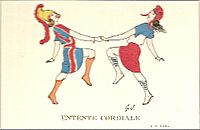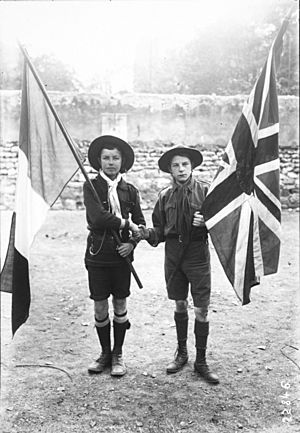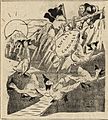Entente Cordiale facts for kids

|
|
| Signed | 8 April 1904 |
|---|---|
| Signatories | |
| Languages | French, English |
| Foreign alliances of France | |||||||||||||||||||||||||||||||||||||||||||||||||||||||||||
|---|---|---|---|---|---|---|---|---|---|---|---|---|---|---|---|---|---|---|---|---|---|---|---|---|---|---|---|---|---|---|---|---|---|---|---|---|---|---|---|---|---|---|---|---|---|---|---|---|---|---|---|---|---|---|---|---|---|---|---|
|
|||||||||||||||||||||||||||||||||||||||||||||||||||||||||||
The Entente Cordiale (which means "Cordial Agreement" in French) was a set of agreements signed on 8 April 1904. These agreements were made between the United Kingdom and the French Republic. They greatly improved the relationship between France and Britain.
At first glance, the agreements seemed to be about small issues like fishing rights and colonial borders. For example, Britain agreed that Egypt was its area of influence. France, in turn, got the same recognition for Morocco. The Entente was not a formal alliance. It did not involve close military teamwork, and it was not meant to be against Germany. However, it did help France and Britain become closer. This was important as Germany's power grew. It is important not to confuse this with the official Anglo-French military alliance, which started later, during World War I in 1914.
The main part of the agreement dealt with colonies. Britain recognized France's influence in Morocco. France recognized Britain's influence in Egypt. France also agreed to respect Spain's interests in Morocco. At the same time, Britain gave the Los Islands (near French Guinea) to France. Britain also set the border of Nigeria in France's favor. France gave up its special fishing rights near Newfoundland. Both countries also outlined areas of influence in Siam (Thailand), which was never colonized. This agreement helped end nearly a thousand years of occasional fighting between the two nations.
The Entente Cordiale was a big success for Théophile Delcassé. He was France's foreign minister from 1898 to 1905. He believed that a good understanding with Britain would protect France from Germany's alliances. Paul Cambon, France's ambassador in London, and Lord Lansdowne, the British Foreign Secretary, were key to making this agreement happen. Before this, Britain had only Japan as a major ally. France only had the Franco-Russian Alliance. The agreement worried Germany, which had relied on France and Britain being enemies. When Germany tried to challenge France in Morocco in 1905, it only made the Entente stronger.
Contents
What Does "Entente Cordiale" Mean?
The term Entente Cordiale means "cordial agreement" or "friendly understanding." It was first used in 1843 by British Foreign Secretary Lord Aberdeen. He wrote about a "cordial, good understanding" between Britain and France. This was later used by King Louis Philippe I of France. Today, the term almost always refers to the agreement signed in London on 8 April 1904.
Why Did Britain and France Become Friends?
This agreement was a big change for both countries. France had been somewhat isolated in Europe. This was partly due to the Napoleonic Wars and its defeat in the Franco-Prussian War of 1870–71. German Chancellor Otto von Bismarck worked to keep France from finding allies. He thought France might want revenge for its defeat.
Britain had followed a policy called "splendid isolation" for nearly a century. This meant staying out of European affairs unless British interests were at risk. However, things began to change for both Britain and France in the late 1800s. Britain started to worry about Germany's growing power. After the Second Boer War, Britain felt less confident.
As early as 1881, French statesman Léon Gambetta and the Prince of Wales, Albert Edward, talked about an alliance against Germany. But the "Scramble for Africa" (when European powers rushed to claim African lands) made it hard for them to agree. Britain also had talks with Germany between 1898 and 1901. However, Britain decided not to join Germany's alliance. Instead, they decided to try for a British-French alliance again.
When the Russo-Japanese War was about to start, France and Britain faced a problem. They could have been pulled into the war because of their allies. France was allied with Russia, and Britain had an alliance with Japan. To avoid war, both countries decided to put aside their old rivalries. They worked out their differences in Africa, the Americas, Asia, and the Pacific. French Foreign Minister Théophile Delcassé and British Foreign Secretary Lord Lansdowne negotiated the colonial agreements. Lord Lansdowne and Paul Cambon, the French Ambassador, signed the final agreement on 8 April 1904.
What Documents Were Signed?
The Entente Cordiale was made up of three main documents:
- Egypt and Morocco: The first and most important document was about Egypt and Morocco. France promised not to interfere with British actions in Egypt. In return, Britain promised to let France "preserve order" and help in Morocco. The agreement also guaranteed free passage through the Suez Canal. It also said no forts could be built on part of the Moroccan coast. There was a secret part of the treaty. It talked about what would happen if the way either country was governed changed.
- Newfoundland and Africa: The second document dealt with Newfoundland and parts of West and Central Africa. France gave up its old fishing rights on Newfoundland's western coast. However, French fishermen could still fish there. In return, Britain gave France the town of Yarbutenda (near modern Senegal and the Gambia). Britain also gave France the Iles de Los (part of modern Guinea). There was also an agreement about the border between French and British lands east of the River Niger.
- Siam, Madagascar, and New Hebrides: The last document was about Siam (Thailand), Madagascar, and the New Hebrides (Vanuatu). In Siam, Britain recognized a French area of influence east of the Menam (Chao Phraya) River. France recognized a British area of influence to the west. Both countries eventually agreed not to take over Siamese land. Britain also stopped objecting to France putting a tariff (a tax on imports) in Madagascar. Finally, they agreed to solve problems about who had power over the native people of the New Hebrides.
What Happened After the Entente?
Some people in the British Foreign Office were not sure what the Entente truly meant. For example, in 1911, Eyre Crowe wrote that the Entente was "nothing more than a frame of mind." He thought it might not be strong in a real emergency.
However, this idea proved wrong. The Triple Alliance (Germany, Austria-Hungary, and Italy) fell apart when Italy stayed neutral at the start of World War I. But the Entente Cordiale lasted. It became a strong bond between Britain and France.
How Was the Entente Cordiale Remembered?
In 2004, the 100th anniversary of the Entente Cordiale was celebrated. Many official and unofficial events took place. Queen Elizabeth II visited France in April. French President Jacques Chirac visited Britain in November. For the first time, British troops led the Bastille Day parade in Paris. The Red Arrows (a British air display team) flew overhead.
At London Waterloo International and Paris Gare du Nord train stations, posters showed the flags of the United Kingdom and France. The words 'Entente cordiale' were on them. Some French leaders had complained about the name "Waterloo" for the London station. This is because the Battle of Waterloo in 1815 was where a British-led army defeated Napoleon. However, in 2007, St Pancras International became the new London station for the Eurostar train.
Entente Cordiale Scholarships
The name "Entente Cordiale" is also used for a special scholarship program. The Entente Cordiale Scholarships scheme was announced in 1995. It was created by British Prime Minister John Major and French President Jacques Chirac. This program helps British and French students study for one year in the other country. The goal is to help future leaders from both countries understand each other better. It also promotes exchanges between them.
See also
 In Spanish: Entente Cordiale para niños
In Spanish: Entente Cordiale para niños
- Anglo-French Supreme War Council
- France–United Kingdom relations
- Auld Alliance
- British military history
- Causes of World War I
- Diplomatic history of World War I
- Foreign relations of France
- Franco-British Council
- History of the foreign relations of the United Kingdom
Images for kids




